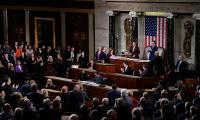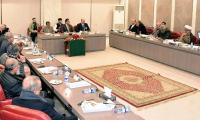LONDON/BEIJING/DHAKA/NEW DELHI: Coronavirus misinformation spread by Russian and Chinese journalists is finding a bigger audience on social media in France and Germany than content from the European nations´ own premier news outlets, according to new research.
The pandemic has killed over 506,000 people worldwide since it surfaced in China late last year, international media reported on Monday. More than 10,335,800 million people have been infected in 196 countries and territories. The United States is the hardest hit country. It is followed by Brazil, Britain, Italy and France.
Whether it is distorted coverage or outright conspiracy theories, articles written in French and German by foreign state media are resonating widely on Facebook and Twitter, often with their origins unclear, the Oxford Internet Institute said in a report published on Monday.
The institute, which is part of Oxford University, looked at content generated by leading media outlets from Russia and China, as well as from Iran and Turkey -- all of which are state-controlled or closely aligned to regimes in power.
Its report comes as the US government imposes new restrictions on Chinese state media, and builds on previous research by the institute that laid bare the penetration of such foreign outlets in English-language markets. In their French, German as well as Spanish output, state media groups have “politicised the coronavirus by criticising Western democracies, praising their home countries, and promoting conspiracy theories about the origins of the virus”, the institute said. “A majority of the content in these outlets is factually based. But what they have, especially if you look at the Russian outlets, is an agenda to discredit democratic countries,” Oxford researcher Jonathan Bright said. “The subtle weave in the overarching narrative is that democracy is on the verge of collapse.”
The institute looked at output from Russia´s RT broadcaster and Sputnik news agency; China Global Television Network (CGTN), China Radio International (CRI) and Xinhua News Agency; plus foreign-language output from Iranian and Turkish networks. It measured median engagement per shared article — how many times a user actively shares or likes an article on Facebook, or comments about it and retweets it on Twitter. The study covered each outlet´s 20 most popular stories from May 18 to June 5.
French-language content from RT scored an average of 528 in user engagement on the two platforms, and 374 for Xinhua, compared to 105 for the newspaper Le Monde.
In German, RT articles scored 158 on Facebook and Twitter, against 90 for Der Spiegel. The institute´s previous study in April found that in English, heavily politicised news stories from the same state media groups could achieve as much as 10 times the level of user engagement as more sober sources such as the BBC.
Bright added: “A significant portion of social media is people consuming content that is directly funded by foreign governments, and it´s not very clear to the reader that that´s the case.”
Similar engagement levels showed in Spanish-language content, including from the Iranian state broadcaster´s service HispanTV, which the report said shares the Russian outlets´ promotion of “anti-US sentiments” for audiences in Latin America.
In contrast, Russian, Chinese and Iranian media all promoted baseless theories, including that the US military unleashed the coronavirus, which originated late last year in the Chinese city of Wuhan. The media organisations in question claim to offer a non-Western perspective on news and deny they are propagandists.
Last week, China threatened to retaliate after four more of its media groups were reclassified as “foreign missions” in the United States. The quartet joined CGTN, CRI and Xinhua, which were already designated by Washington as state-sponsored actors, rather than as media.
In Britain, RT has been fined for breaking rules on media impartiality.
In France, President Emmanuel Macron accused the Russian network of spreading “deceitful propaganda” during the 2017 presidential election.
Meanwhile, China´s military has approved a coronavirus vaccine for use within its ranks that has been developed by its research unit and a biotech firm, the company said Monday.
Organisations around the world are racing to find ways to treat and prevent the deadly pathogen, which first emerged in the central Chinese city of Wuhan and has since killed over half a million people worldwide. More than half of 17 candidate vaccines identified by the World Health Organisation (WHO) that are in clinical evaluation involve Chinese companies or institutes.
Hong Kong-listed CanSino Biologics said in a filing to the stock exchange that data from clinical trials showed the Chinese military vaccine had a “good safety profile” and potential to prevent disease caused by the novel coronavirus.
CanSino said Monday that China´s Central Military Commission approved the use of the vaccine on June 25, for one year. The vaccine was jointly developed by CanSino and the Beijing Institute of Biotechnology, part of the Academy of Military Medical Sciences.
Its use cannot be expanded without further approvals, the listing said. It was not clear how widely it would be used within China´s enormous military forces, and the ministry of defence did not reply to an AFP request for further information.
CanSino added that it cannot guarantee the vaccine — which had its phase one and two clinical trials done in China — will ultimately be commercialised.
Another 131 candidate vaccines listed by the WHO are in the pre-clinical phase. None have yet been approved for commercial use against the coronavirus.
Meanwhile, Iran reported on Monday 162 more deaths from the novel coronavirus, the highest single-day toll since the country´s outbreak began in February. “This increase in numbers is in fact a reflection of our overall performance, both in terms of reopening and in compliance with health protocols,” health ministry spokeswoman Sima Sadat Lari said at a news conference.
The previous record daily toll of 158 deaths was reported by health authorities in early April. Official figures have shown an upward trajectory in new confirmed cases since early May, when Iran hit a near two-month low in daily recorded infections.
Iran reported its first COVID-19 cases on February 19 and it has since struggled to contain the outbreak, the deadliest in the Middle East. Lari announced an additional 2,536 new cases on Monday, bringing the total to 225,205. The overall official death toll is now at 10,670.
Iranian authorities have refrained from enforcing full lockdowns to stop the pandemic´s spread and the use of masks and protective equipment has been optional in most areas. Iran closed schools, cancelled public events and banned movement between its 31 provinces in March, but the government progressively lifted restrictions from April to try to reopen its sanctions-hit economy.
According to Lari, the provinces of Khuzestan, Hormozgan, Kurdistan, Kermanshah, Boushehr, West and East Azerbaijan and Khorasan Razavi are classified as “red”. The provinces of Ilam, Lorestan and Golestan are on alert, she added.
While, Bangladesh reported over 4,000 new COVID-19 cases on Monday, bringing the total in the country to nearly 142,000. Senior Health Ministry official Nasima Sultana said in a briefing Monday afternoon that “4,014 new COVID-19 positive cases and 45 deaths were reported in the last 24 hours across Bangladesh. The number of confirmed infections in the country totaled 141,801 while fatalities stood at 1,783,” she said.
She said the total number of recovered patients in the country now stands at 57,780 including 2,053 on Monday.
Meanwhile, With 19,459 coronavirus cases in the past 24 hours, India’s nationwide tally on Monday morning hit 548,318, according to the Health Ministry. Of these, the last 100,000 cases have been added in the past week.
Meanwhile, the death toll reached 16,475 with 380 more fatalities. A total of 321,723 people in the country have gone on to make a recovery.
Amid the surge, several states including eastern states of Jharkhand and West Bengal, and northeastern Assam and Manipur have re-imposed partial or full lockdown. “It was mentioned that presently eight states - Maharashtra, Delhi, Gujarat, Tamil Nadu, Telangana, Uttar Pradesh, Andhra Pradesh, and West Bengal - contribute 85.5 percent active caseload and 87 percent total deaths in India,” read a statement from the ministry.
The western state of Maharashtra, which includes the financial capital Mumbai, continues to be the worst-affected state in the country with cases rising to 164,626 and death toll jumping to 7,429, according to the ministry. The state, the epicenter of the country, reported 5,493 new cases and 156 deaths in the last 24 hours. Out of 156 deaths, 60 occurred in the last 48 hours. The capital Delhi reported 2,889 new positive cases and 65 deaths.
Meanwhile, the first clinical trial of China’s COVID-19 mRNA vaccine is underway in east China’s Hangzhou City and on Monday afternoon, volunteers received their first dose at Shulan Hospital.
The project started enrolling volunteers on June 23, and plans to recruit 168 healthy individuals, half of them aged 18 to 59 years old and the other half aged at least 60 years, to evaluate the safety and tolerance of the new coronavirus (SARS-CoV-2) mRNA vaccine, CGTN reported.
The hospital posted a recruiting announcement on its account on WeChat, a social media platform, on June 24. Volunteers will receive two doses of the vaccine, and do not need to be hospitalised during the trial period. Researchers can leave the research center after confirming the absence of any abnormality.
Shulan Hospital staff they are still recruiting more volunteers.
ARCoV, a novel coronavirus Messenger RNA (mRNA) vaccine candidate jointly developed by the People’s Liberation Army (PLA) Academy of Military Sciences, Suzhou Abogen Biosciences and Walvax Biotechnology Co Ltd was officially approved by the National Medical Products Administration for clinical trial on June 19. This is the first COVID-19 mRNA vaccine to have been approved for clinical trials in China.
Kuwait on Monday reported 582 new COVID-19 cases and two more deaths, raising the tally of infections to 45,524 and the death toll to 350, the Health Ministry said in a statement.
The new cases included 319 Kuwaiti nationals, the statement said.
Currently, 8,861 patients are receiving treatment, including 145 in ICU, according to the statement. The ministry also announced the recovery of 819 more patients, raising the total recoveries in the country to 36,313. On June 25, Kuwait decided to start the second phase of restoring normal life. The second phase will begin on June 30 and will last for three weeks.
In the second phase, public and private sectors will resume work with less than 30 percent capacity, in addition to the resumption of operation in shopping malls, financial sector, construction sector, retail shops, parks, and pick-ups from restaurants and cafes.
Kuwait and China have been supporting each other and cooperating closely in combating the COVID-19 pandemic.
Hospital Director Dr Khalid Masud said that hospital had reduced number of patient referrals to other hospitals by 90%
Maryam strongly condemned bomb blast in Turbat, and paid tribute to all those who lost their precious lives in explosion
First track spans 10.1 kilometres, stretching from Sea View to gate of Golf Club
According to local media, unidentified gunmen burst into bar La Casita Azul and opened fire at customers
Bureau of Meteorology official Miriam Bradbury said temperatures would likely peak in Victoria
Such tool allows budget-related bills to clear 100-member Senate with simple majority, rather than typical 60-vote...







